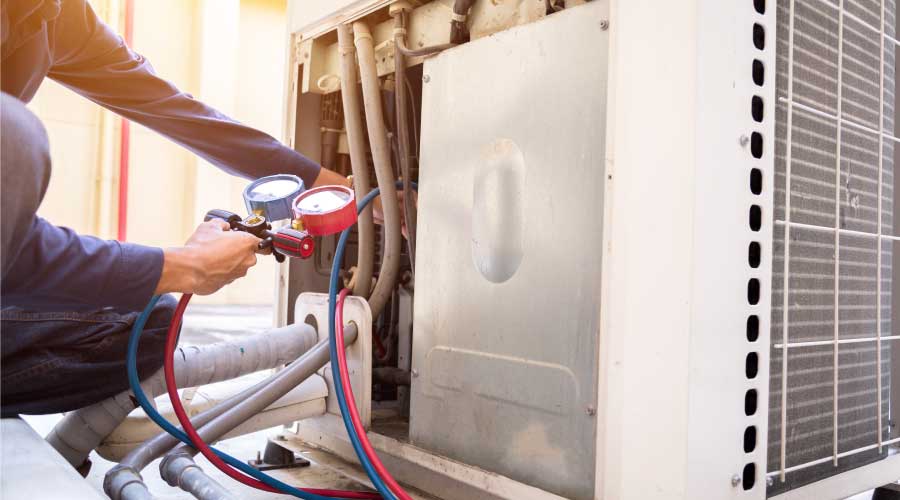Top-Level HVAC Maintenance
Rooftop equipment presents unique challenges, but planning and PM can enhance efficiency and extend performance life
In many instances, the value of real estate or the desire to place equipment out of sight leads facilities to place an array of HVAC equipment on the roof. This rooftop equipment presents maintenance and engineering managers and technicians with unique challenges, primarily related to weather and access.
The first priority for managers is to ensure correct installation and operation. Improper installation and start-up can result in early failure and additional maintenance throughout the life of the equipment. Beyond installation, preventive maintenance (PM) is essential.
In developing a PM plan, managers should be aware of specific types of equipment located on roofs, service concerns and roofing-system protection. Common roof-mounted equipment includes fans, air-handling units (AHUs), make-up air units, air-cooled chillers, condensers, cooling towers, and ductwork. All rooftop equipment needs routine maintenance of varying degrees.
Fans
The type of fan — whether a standard centrifugal exhauster or a large belted vent set — determines maintenance requirements. A first-time inspection of fans should include a visual check for an available electrical disconnect within sight of the motor. A typical fan requires a belt adjustment and a check on pulley alignment three weeks after start-up and then every three months.
Ongoing maintenance includes checking dampers and actuators for operability every three to six months. Fans of more than 1 horsepower require lubrication of some motor bearings and fan wheels, depending on whether or not they are permanently sealed. Technicians should replace grease every 2,000 hours of run time, but in temperatures higher than 104 degrees, technicians should replace grease more frequently.
Manufacturers can provide published lubrication schedules for specific fan makes and models. Technicians should check fan wheels annually for dirt build-up, unless the operating medium dictates checking more often. They also should check set screws in bearing collars annually because loose collars cause premature failure.
Air-handling Units
The most common AHUs include chilled-water or direct-expansion (DX) units for cooling, hot-water or gas-fired units for heating, and energy-recovery units that use heat wheels or run-around coils. All of these units have parts in common — fans, dampers and actuators, coils and housings — that need routine maintenance.
Managers should schedule fan, damper and actuator maintenance as discussed previously. Semiannually, technicians should check coils, casings and intake hoods for corrosion. They should check drains and drain pans on cooling units and clean them every three to six months.
It is particularly important to inspect drains for obstructions. Plugged drain lines cause pans to overflow, and the resulting condensate will find its way into buildings. Standing water in drain pans also can cause indoor air quality (IAQ) issues resulting from mold and algae growth. A quick drain inspection can prevent serious headaches down the road.
Managers should size condensate drain traps correctly to keep traps wet and allow water to flow out of drain pans. Normally, the coil section is in a draw-through configuration, and the trap depth is two times the static pressure in the pan section.
For example, a pan with a 3-inch static pressure will need a 6-inch trap to keep from pulling in air through the trap. If the coil is in the blow-through position, there is no need to worry about pulling in air, but blowing out air is a concern. The same formula applies in this configuration.
Filter maintenance on AHUs varies depending on the filter media, relative air cleanness and filtration levels. If filters become overly loaded, the system has to work harder, using more energy. Reduced airflow can affect coils, which can even freeze on some DX units, and IAQ will suffer. Managers should place filter maintenance on a set schedule ranging from monthly to annual filter replacement, based on system requirements.
An annual inspection of AHUs should consist of:
- inspecting the casing
- cleaning the fan wheels and shafts
- inspecting drain pans and lines
- checking damper linkages and set screws
- cleaning damper operators.
Inspectors also should check control power and line-voltage boxes for secure wiring, and they should check gaskets, flex connections and wood nailers at curbs.
Gas-fired AHUs require additional maintenance. Each season, technicians should check burners and orifices for debris, spider webs and other obstructions. They also should check flue collector boxes annually and clear them of debris. Upon installation, inspectors should verify that exhaust gases are not being entrained back into the building or otherwise causing air quality issues.
DX equipment requires maintenance of some parts already covered, as well as of compressors and condenser coils. Maintenance of these units should incorporate previously mentioned checks, as well as checking the refrigerant charge and cleaning condenser coils. An initial installation check should verify that condenser coils have a clear air circulation path, since obstructions can dramatically reduce capacity.
Chillers and Condensers
Air-cooled chillers use one of three basic types of compressors – scroll, reciprocating and rotary screw. Each type requires different maintenance and inspection, so technicians should follow manufacturers’ published maintenance schedules to get the maximum life from these units.
In addition to compressors, air-cooled chillers have condenser fans — belt driven or direct drive — that also require maintenance. If a chiller barrel is subject to freezing, technicians should insulate and heat-trace the unit, or they should add a mixture of glycol to the chilled water. They also should check the heat trace or glycol mixture seasonally.
Air-cooled condensers are usually DX units. These units commonly consist of a simple coil and propeller or centrifugal fans to aid in heat dissipation. Fan service suggestions previously mentioned will cover most applications of condensing units.
Cooling Towers
Upon initial installation of cooling towers, workers should inspect them for unobstructed airflow around the tower, as well as for adequate freeze protection for the sump, make-up lines, overflow lines, and other exposed water lines that do not drain at shutdown.
Much has been written on cooling tower maintenance, but no matter the type of system used for cooling tower water treatment, keeping a close eye on bacteria and dissolved solids is essential for an efficient and long-performing cooling tower.
Managers should set up a maintenance schedule and tailor it to the specific tower and the conditions under which it operates. Consulting with the tower manufacturer and water treatment specialist can ensure the treatment approach is compatible with tower materials.
At a minimum, technicians should check towers each month for fan-motor and bearing lubrication, as well as for tight thrust or locking collars and fan belts. Workers should clean strainers and sumps monthly, check the operating water level, adjust float valves if required, verify the bleed-off rate, and clean debris from inlet screens.
Managers can extend the performance life of rooftop HVAC equipment by establishing a specific checklist and schedule for each specific piece of equipment. A comprehensive PM plan is key to equipment longevity and addressing problems while they are small.
A good PM plan also can go a long way in helping a manager maintain the integrity of the roof envelope.
Protecting Roofs and Workers
Despite workers’ best intentions, the installation and routine maintenance of rooftop HVAC equipment can damage roof materials. To prevent such potential problems, managers can establish equipment installation guidelines that also protect roofing systems and materials.
For example, during installation, managers should make sure that installers and technicians insulate panel corners from the roof, especially if the roof is a membrane type and that they secure panels and equipment to avoid having them blow off in high winds.
Once is complete, workers should:
- pick up screws and other fasteners, which are often left behind and scattered on the roof, because these items easily puncture membrane roofs
- take special care when using grease, oil, refrigerants and cleaners that can damage roof materials
- pay close attention to standing condensate on roofing, as it can cause algae and bacterial growth and create a fall hazard.
Condensate also can cause problems with internal gutter systems if they are not properly insulated or routed, resulting in condensation on perimeter gutters and downspouts.
Most roof leaks occur in association with rooftop equipment, so proper curb cuts and flashing are essential for preventing such problems. Before installation of any roof-mounted equipment, managers and technicians should consult specific and detailed plans that indicate the methods for attaching items to the roof structure and the extent of flashing and roofing materials needed to ensure roof integrity.
Workers should visually inspect all curbs prior to setting equipment. Once equipment is set, it is very difficult to modify curb flashing and roofing materials. Minimizing the number of roof penetrations from equipment and supports should be a priority.
Finally, routine foot traffic is a concern on most roofs. In the preventive maintenance plan, managers should establish a pathway with walk-off matting and clear guidelines on access to the roof area.
Worker Safety
To maintain worker safety during maintenance of rooftop equipment, managers should consider these suggestions in developing a safety plan:
- Make certain a power disconnect is within eyesight of equipment served.
- Install guard rails and platforms where regular maintenance is required but cannot be performed while standing on the roof.
- Mark trip hazards — such as expansion joints, vents and pipes — that cross the roof.
- Build walkways over trip hazards in areas of consistent foot traffic to allow for easier movement of workers, materials and tools.
- Provide adequate lighting around rooftop equipment.
|
Related Topics:











